It is the year 1876 in Kessel, a tiny, idyllic village on a rivershore in the south-east Netherlands. Bypassing skippers recognise the town from the recently completed neogothical church and the bold, medieval castle Keverberg, that seem in peaceful coexistence. But reality is quite different. The lord of the castle and the priest are in a conflict that eventually will lead to a mystery that will be told from generation to generation during the upcoming 150 years.
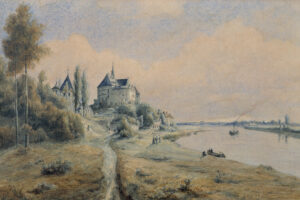
On Wednesday September 27th, baron Frederick Henry Charles of Keverberg is near death in his house Villa Oeverberg, a few hundred feet upstream of his castle. After only 51 years, illness and alcohol are about to end his turbulent, miserable life. In his last will, written a few days ago, it says that Baron Frits, as villagers tend to call him, blames his mother, brother and daughter for his decay, because they all turned their back on him. As a result of a dispute with the priest he has stated that he shall not be buried according to catholic rituals. Instead, he offers his body for scienific purposes to the University of Leiden, where he once studied. However, the university kindly rejects and the baron never makes it to the cemetery. What does happen to his remains, no-one knows. The body seems to have vanished in the air, those last days of September 1876.
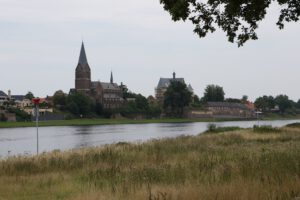
Who was Baron Frits and what turned him into the lonely, bitter man whose body disappeared during the mid-nineteenth century? Frederick Henry was born July 22th 1825 in Stonor, England, as the second child of the british Mary Lodge and the dutch baron Charles Louis of Keverberg. The father was a political hotshot. He had served under Napoleon during the french occupation and turned to King William 1 after the French were expelled. He died in 1841 and his family moved to Castle Keverberg in Kessel. At that time, Frits was a law student in Leiden and already had his first disputes with the Van Wylick-family, a powerful dynasty that Frits accused of stealing his property. Despite these fights, Frits became town councellor in 1851. Shortly after that, his mother and siblings left Keverberg to move to another castle, Aldenghoor in the nearby village of Haelen. Frits was alone in his castle, but not for long.
1857 he married Louise Villers de Pité, who gave birth to their daughter Mary Mathile a few years later. But the joy of a child could not consolidate the marriage. It was widely known that the castle was the scene to many terrible fights between the couple, eventually resulting in Louise fleading. When little Mary Mathilde was seven years old, she was taken away by her grandmother to never be brought back. The child spend her youth in several boarding schools. She even lived a while under a false name in Duesseldorf, Germany, to keep her hidden from her father. In 1859 Baron Frits lost his position in the town council, but he was not ready to let that happen. The next meeting, half past nine in the morning, he entered the room, obviously drunk, only to insult his successor. During a game of cards with some high placed friends in The Hague, Frits got an argument with a Prussian prince. Only diplomatic intervention could restrain them from a duel with pistols.
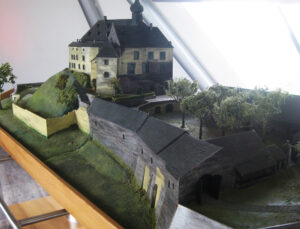
In 1869 it was priest Simons’ turn to become subject to baron Frits’ rage. Simons had the old church torn down and replaced by a new and bigger house of God. The old building had stood partly on the castle’s ground and tradition had it that this part was therefore exclusively for the habitants of the castle. This was not the case with the new church and thus the priest considered the tradition to be outdated. For compensation, Simons offered the baron the first row in church, but Frits did not accept that. He attended the first masses outside, on the exact spot where his old, private bench had been.
The priest critisized his default of catholic obligation, but baron Frits replied that he was very capable of getting to peace with God by himself. He never attended a mass again and his separation with the catholic church was definate. This was the reason why Frits did not want to be buried according to catholic tradition and therefore the cause of the mysterious disappearance of his dead body.
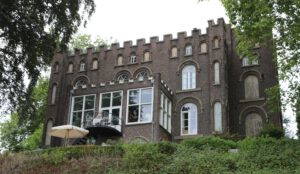
Was he buried in the gardens of his house Villa Oeverberg? The castle’s gardens? The family tomb in Haelen? The latter was not very likely, since Frits had disputes with his relatives as well. It is said that on his deathbed he had a loaded revolver standby, just in case his mother and siblings would come to say farewell. True or not, it is a fact that in his last will it can be read that he left serious sums of money to his maid and his servant, under the condition they would succeed to keep his relatives out.
Thus, a myth was born and told from father to son to grandson. Albeid it was not really all that mysterious. The dutch writer and historian Jacobus Craandijk visited the castle in 1880 and wrote about an overgrown grave in a corner of the yard, that was said to contain the castle’s last noble inhabitant. Although that assertion could not stop the myth, it does help a lot when over a century later, June 25th 2015, workers find a lead coffin in the castle’s garden.
A month later the coffin is opened by forensic antropologue Birgit Berk. She scrutinises the remains to conclude that they belonged to a 44 to 53 year old male, 175 to 179 centimeters tall. That suits with the few things we know about baron Frits. Stains on the inside of the ribs witness of a heavy case of pneumonia, perhaps tuberculosis, which could very well be the disease that killed the baron back in 1876. The lead coffin and hardly worn (i.e. little physical labor) joints make it likely this was a wealthy man.
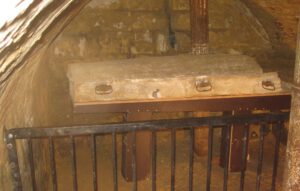
Alltogether it is almost sure that the lost body of baron Frits is back, almost 139 years afte rit vanished. Still, we will probably never be hundred percent sure. That would need a DNA-match, but who to match with? His daughter Mary Mathilde became a nun and was buried in the convent’s cemetery, which was emptied in 1976, with all the bones thrown in a mass grave. Only Frits’ sister Elfrida’s remains can be found in a markes grave in the city of Roermond. Should she be exhumed? Perhaps it is better to spare what’s left of the mystery.
This article was published November 2015 in Quest Historie













